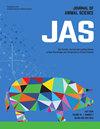口服褪黑素对公牛精子质量和睾丸动脉血流动力学的影响
IF 2.9
2区 农林科学
Q1 AGRICULTURE, DAIRY & ANIMAL SCIENCE
引用次数: 0
摘要
本研究的目的是研究口服褪黑素对公牛精子质量和睾丸动脉血流动力学的影响。一岁安格斯公牛(n = 21)随机分为两组,一组喂食褪黑素(MEL);n = 11)或对照组(CON;N = 10),治疗90天。MEL公牛添加200 mg/kg体重的乙醇溶褪黑素,CON公牛添加等量的乙醇对照。在2024年10月至2025年1月期间,每天通过CALAN门饲系统饲喂一种谷物混合物。收集体重,每周调整褪黑素补充量。基线测量在给药前2±1天收集。在第28、56和84天采集阴囊围(SC)和精液样本。通过电射精获得精液样本,并通过计算机辅助精子分析评估其形态和运动参数。睾丸动脉血流动力学测量(TBF);总血流量RI;阻力指数PI;脉搏指数S/D;收缩压与舒张压比;分别于第14、28、42、56、70天通过多普勒超声采集左、右睾丸的平均速度。计算相对于体重的总血流量(BF/BW)和平均血管直径(DIA)。以治疗、时间和相互作用作为固定效应,使用SAS特异性重复测量的MIXED程序分析数据。初始协变量包括兴趣基线变量、年龄、体重、SC和温度湿度指数。使用反向手动选择去除协变量,其中变量具有P &;lt;0.1被留在模型中。添加褪黑激素可使MEL的精子活力(82.52±2.41)高于CON的(75.52±2.22)(P = 0.0496); MEL的精子活力(51.93±0.36)高于CON的(53.03±0.32)(P = 0.051)。进行性运动、搏动交叉频率、平均路径速度、曲线速度和直线速度改善(P <;0.05)。相比之下,远端液滴计数、线性度和直线度下降(P <;0.05)。没有效果(P >;睾丸动脉血流动力学治疗差异0.05)。但PI、RI、S/D、TBF和BF/BW发生了变化(P <;0.05)。PI、RI和S/D降低(P <;0.05),第14 ~ 56 d。相比之下,TBF和BF/BW增加了(P <;0.05) (d 14 ~ d 56)。从第14天到第70天,MnV有升高的趋势(P = 0.0687), DIA有降低的趋势(P = 0.0576)。从秋天到冬天补充褪黑素导致精子活力显著增加,尽管治疗没有改变睾丸动脉血流动力学。本文章由计算机程序翻译,如有差异,请以英文原文为准。
41 Impact of oral melatonin supplementation on sperm quality and testicular artery hemodynamics in the bull
The objective of this study was to examine the impact of oral melatonin supplementation on sperm quality and testicular artery hemodynamics in the bull. Yearling Angus bulls (n = 21) were randomly allocated into two groups, either melatonin fed (MEL; n = 11) or control fed (CON; n = 10) for 90 days of treatment. MEL bulls were supplemented with 200 mg/kg of body weight of melatonin dissolved in ethanol, while CON bulls were supplemented with an equivalent ethanol vehicle control. Supplementation was top-dressed in a grain mix, fed daily via the CALAN gate feeding system from October 2024 to January 2025. Body weight was collected, and melatonin supplementation was adjusted weekly. Baseline measurements were collected 2 ± 1 d prior to treatment administration. Scrotal circumference (SC) and semen samples were collected on d 28, 56, and 84. Semen samples were obtained via electroejaculation and evaluated by computer-assisted sperm analysis for morphology and motility parameters. Testicular artery hemodynamic measurements (TBF; total blood flow, RI; resistance index, PI; pulsatility index, S/D; systolic to diastolic ratio, MnV; mean velocity of the left and right testis), were collected on d 14, 28, 42, 56, and 70 via Doppler ultrasonography. In addition, total blood flow relative to body weight (BF/BW) and average blood vessel diameter (DIA) were calculated. Data were analyzed using the MIXED procedure of SAS specific for repeated measures with treatment, time, and the interaction as fixed effects. Initial covariates included the baseline variable of interest, age, weight, SC, and temperature humidity index. Covariates were removed using backwards manual selection with variables having a P < 0.1 being left in the model. Melatonin supplementation increased sperm motility (P = 0.0496) in MEL (82.52 ± 2.41) compared to CON bulls (75.52 ± 2.22) and wobble tended to decrease (P = 0.051) in MEL (51.93 ± 0.36) compared to CON bulls (53.03 ± 0.32). Progressive motility, beat cross frequency, average path velocity, curvilinear velocity, and straight-line velocity improved (P < 0.05) over time. In contrast, distal droplet count, linearity, and straightness decreased (P < 0.05) over time. There was no effect (P > 0.05) of treatment on testicular artery hemodynamics. However, PI, RI, S/D TBF, and BF/BW changed (P < 0.05) over time. PI, RI, and S/D decreased (P < 0.05) from d 14 to 56. In contrast, TBF and BF/BW increased (P < 0.05) from d 14 to d 56. MnV tended (P = 0.0687) to increase and DIA tended (P = 0.0576) to decrease from d 14 to d 70. Melatonin supplementation from fall to winter resulted in a notable increase in sperm motility despite the lack of alterations to testicular artery hemodynamics due to treatment.
求助全文
通过发布文献求助,成功后即可免费获取论文全文。
去求助
来源期刊

Journal of animal science
农林科学-奶制品与动物科学
CiteScore
4.80
自引率
12.10%
发文量
1589
审稿时长
3 months
期刊介绍:
The Journal of Animal Science (JAS) is the premier journal for animal science and serves as the leading source of new knowledge and perspective in this area. JAS publishes more than 500 fully reviewed research articles, invited reviews, technical notes, and letters to the editor each year.
Articles published in JAS encompass a broad range of research topics in animal production and fundamental aspects of genetics, nutrition, physiology, and preparation and utilization of animal products. Articles typically report research with beef cattle, companion animals, goats, horses, pigs, and sheep; however, studies involving other farm animals, aquatic and wildlife species, and laboratory animal species that address fundamental questions related to livestock and companion animal biology will be considered for publication.
 求助内容:
求助内容: 应助结果提醒方式:
应助结果提醒方式:


